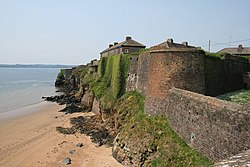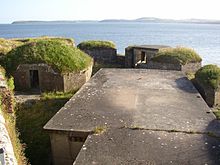
County Wexford is a county in Ireland. It is in the province of Leinster and is part of the Southern Region. Named after the town of Wexford, it was based on the historic Gaelic territory of Hy Kinsella, whose capital was Ferns. Wexford County Council is the local authority for the county. The population of the county was 163,527 at the 2022 census.

Duncannon is a village in southwest County Wexford, Ireland. Bordered to the west by Waterford harbour and sitting on a rocky headland jutting into the channel is the strategically prominent Duncannon Fort which dominates the village.

Loftus Hall is a large country house on the Hook peninsula, County Wexford, Ireland. Built on the site of the original Redmond Hall, it is said to have been haunted by the devil and the ghost of a woman.

The Battle of Vinegar Hill was a military engagement during the Irish Rebellion of 1798 on 21 June 1798 between a force of approximately 13,000 government troops under the command of Gerard Lake and 16,000 United Irishmen rebels led by Anthony Perry. The battle, a major rebel defeat, took place on 21 June 1798 on a large rebel camp on Vinegar Hill and in the streets of Enniscorthy, County Wexford and marked the last major attempt by the rebels to hold and control territory taken in Wexford.

Waterford city is situated in south eastern Ireland, on the river Suir [pronounced Shure] about seventeen miles (27 km) from where the river enters the sea. Practically the entire city is built on the south bank of the river. The "Old town", now the business centre, clusters behind the broad quay-front on a low-lying strip of land left behind by a gentle loop of the river at this point. From this, the land rises sharply to the east and opposite to the west while remaining level in between. The eastern slopes are almost entirely occupied by private residential estates, while the western and southwestern prominences are largely given over to local council housing development. There are corresponding elevations on the north bank eastwards towards Christendom and westwards towards Mount Misery nothing.

The Battle of Three Rocks was a United Irish victory during the Wexford Rebellion, a part of the 1798 rebellion, against a British artillery column marching to reinforce Wexford town against anticipated rebel attack.
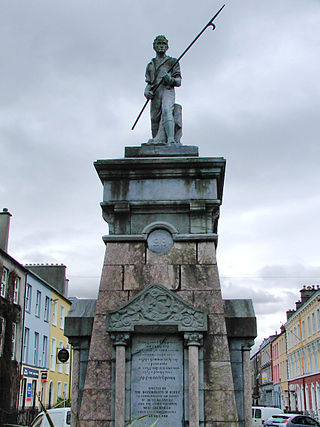
Croppy was a nickname given to United Irishmen rebels during the Irish Rebellion of 1798 against British rule in Ireland.

The city of Waterford in southeastern Ireland was besieged twice during 1649 and 1650 during the Cromwellian conquest of Ireland. The town was held by Irish Confederate Catholic under General Richard Farrell and English Royalist troops under general Thomas Preston. It was besieged by English Parliamentarians under Oliver Cromwell, Michael Jones and Henry Ireton.
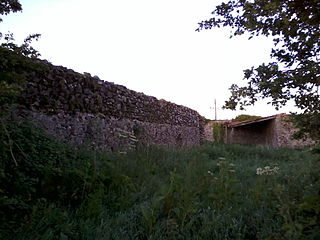
Geneva Barracks in County Waterford, Ireland, was a barracks created in 1783 by converting a settlement which had been created for an 18th-century colony of disaffected citizens of Geneva following the Geneva Revolution of 1782. Built near Passage East, the colony was commissioned by the Irish Parliament and approved by the Crown. After the Genevans abandoned their plans to settle in Waterford, the colony became a military barracks instead. During the Irish Rebellion of 1798, the barracks was transformed into a holding centre for captured United Irishmen rebels, many of whom were executed, transported or conscripted. Today, the only remains of New Geneva are its ruined walls in a grassy field.
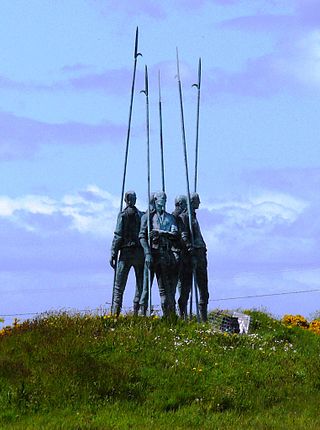
The Wexford Rebellion refers to the events of the Irish Rebellion of 1798 in County Wexford. From 27 May until 21 June 1798, Society of United Irishmen rebels revolted against British rule in the county, engaging in multiple confrontations with Crown forces. The most successful and destructive rising in all the counties of Ireland, United Irishmen rebels experienced a number of early successes in the county despite being seen as a relatively loyal county by the Dublin Castle administration due to a series of military victories. However, the tide soon turned against the United Irishmen in Wexford as Crown forces poured into the region, engaging in a brutal counterinsurgency which indiscriminately targeted suspected rebels and eventually suppressed all rebel activities in the county.
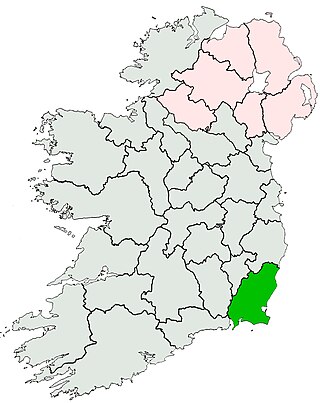
County Wexford is a county located in the south-east of Ireland, in the province of Leinster. It takes its name from the principal town, Wexford, named 'Waesfjord' by the Vikings – meaning 'inlet (fjord) of the mud-flats' in the Old Norse language. In pre-Norman times it was part of the Kingdom of Uí Cheinnselaig, with its capital at Ferns.

Ballyhack is a small village located in the south-west of County Wexford, in Ireland, on the eastern shore of the Waterford Harbour, which is the estuary of The Three Sisters
The siege of Duncannon took place in 1645, during the Irish Confederate Wars. An Irish Catholic Confederate army under Thomas Preston besieged and successfully took the town of Duncannon in County Wexford from an English Parliamentarian garrison. The siege was the first conflict in Ireland in which mortars were utilized.
Presented below is a chronology of the major events of the Irish Confederate Wars from 1641 to 1653. This conflict is also known as the Eleven Years War. The conflict began with the Irish Rebellion of 1641 and ended with the Cromwellian conquest of Ireland (1649–53).
Sir Laurence Esmonde, 1st Baron Esmonde (1570?–1646), was an Irish peer who held office as governor of the fort of Duncannon in County Wexford. He was a leading Irish Royalist commander in the English Civil War, but was later suspected of disloyalty to the English Crown when he surrendered Duncannon Fort to the enemy. He was the ancestor of the Esmonde Baronets, although the barony died with him.
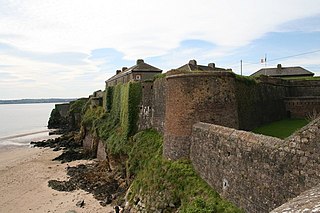
The Governor of Duncannon Fort was a military officer who commanded the garrison at Duncannon in County Wexford. In later years the post became a sinecure and was abolished on the death of the last holder in 1835.

The Capture of Waterford took place in July 1690 during the Williamite War in Ireland when a force under the command of Percy Kirke captured the town of Waterford from its Jacobite Irish Army garrison. Full control of the town was not secured until Duncannon Fort across Waterford Harbour was also taken from its garrison under Michael Burke shortly afterwards. In both cases the garrisons were allowed to march out under escort to Jacobite-held Mallow in County Cork, but were denied the "honours of war" which they demanded.
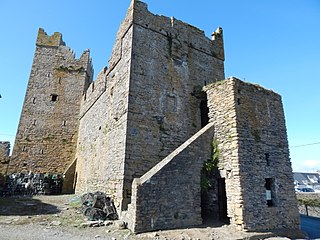
Slade Castle is a tower house and National Monument in County Wexford, Ireland. It is located in the village of Slade on the Hook Peninsula and primarily dates to the late 15th or early 16th century.

The Croppies' Acre, officially the Croppies Acre Memorial Park, is a public park in Dublin, Ireland. It contains a memorial to the dead of the 1798 Rebellion.
